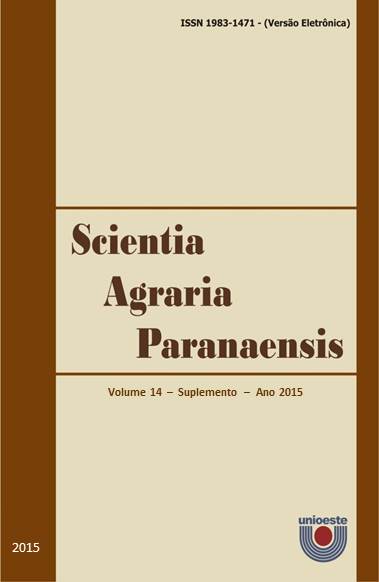Electrical conductivity and pH of surface runoff due to the application of swine culture wastewater and mineral fertilizer in a soil cultivated with soybean
DOI:
https://doi.org/10.18188/sap.v14i0.13321Keywords:
condutividade elétrica, potencial hidrogeniônico, escoamento superficial.Abstract
The intensification of pig farming in Brazil has led to an increase of incorrect wastewater allocation, but fertigation emerges as a potential solution. The aim of this study was to evaluate the electrical conductivity (EC) and pH of surface runoff due to the application of pig farming wastewater (0, 75, 150, 225 and 300 m3 ha-1) and mineral fertilizer (0, 25%, 50%, 75% and 100% of the fertilizer recommendation) in a soil cultivated with soybean under different slopes (4%, 9%, 14%, 19% e 24%) and precipitation intensity (45, 60, 75, 90 e 105 mm h-1). The experiment was conducted using the Rotated Central Composite Design (RCCD), in a 2 x 4 factorial scheme, containing axial and central points, totaling 28 tests. The precipitation was simulated after the fertilizer application, and then the wastewater was collected to evaluate its pH and electrical conductivity. The results revealed that only pig farming wastewater showed significant effect to both electrical conductivity and pH. Moreover, it was verified that the salt concentration in the drained wastewater decreased as time went by.Downloads
Published
01-01-2000
How to Cite
GARCIA, E. B.; DIETER, J.; SAMPAIO, S. C.; SCHMIDT, C. J.; SANTOS, R. F. dos; TESSELE, A. Electrical conductivity and pH of surface runoff due to the application of swine culture wastewater and mineral fertilizer in a soil cultivated with soybean. Scientia Agraria Paranaensis, [S. l.], v. 14, p. 295–299, 2000. DOI: 10.18188/sap.v14i0.13321. Disponível em: https://e-revista.unioeste.br/index.php/scientiaagraria/article/view/13321. Acesso em: 4 jul. 2025.
Issue
Section
Scientific Article
License
Aviso de Direito Autoral Creative Commons
Política para Periódicos de Acesso Livre
Autores que publicam nesta revista concordam com os seguintes termos:
1. Autores mantém os direitos autorais e concedem à revista o direito de primeira publicação, com o trabalho simultaneamente licenciado sob a Licença Creative Commons Attribution que permite o compartilhamento do trabalho com reconhecimento da autoria e publicação inicial nesta revista.2. Autores têm autorização para assumir contratos adicionais separadamente, para distribuição não-exclusiva da versão do trabalho publicada nesta revista (ex.: publicar em repositório institucional ou como capítulo de livro), com reconhecimento de autoria e publicação inicial nesta revista.
3. Autores têm permissão e são estimulados a publicar e distribuir seu trabalho online (ex.: em repositórios institucionais ou na sua página pessoal) a qualquer ponto antes ou durante o processo editorial, já que isso pode gerar alterações produtivas, bem como aumentar o impacto e a citação do trabalho publicado (Veja O Efeito do Acesso Livre).
Licença Creative Commons
Esta obra está licenciada com uma Licença Creative Commons Atribuição-NãoComercial-CompartilhaIgual 4.0 Internacional, o que permite compartilhar, copiar, distribuir, exibir, reproduzir, a totalidade ou partes desde que não tenha objetivo comercial e sejam citados os autores e a fonte.


